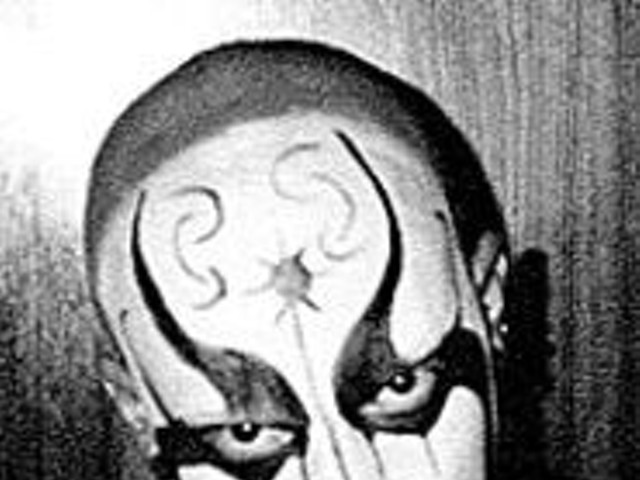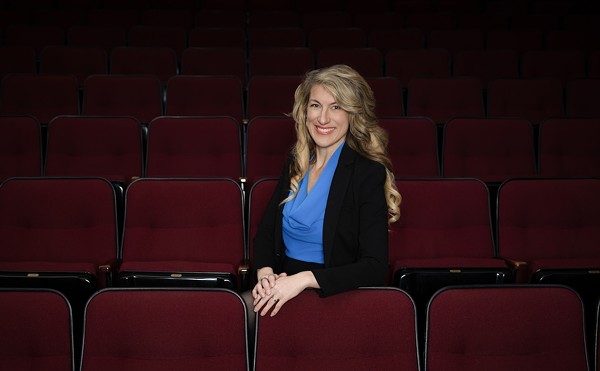Gentele has been executive director of Laumeier Sculpture Park for a little over a year now. Weed-pulling probably isn't listed in his job description, but for Gentele, it was one of his first priorities.
The twenty tons of earth in need of watering, reseeding, new soil, metal supports, new steps, a special grass cutter and constant weeding is "Cromlech Glen," an earthwork by Beverly Pepper. When Gentele took the job of director, he publicly announced that the restoration of "Cromlech Glen" was first on his list of things to do. "It was one of my first priorities," Gentele says in his office, where stacks of artist catalogs are piled on his desk and shelves. "It was and still is. I get really excited about the progress we've made. We have a seminal work in our collection, an earthwork by Beverly Pepper, and removing it was never a consideration for me."
But there was a lot to be done, he says. "The front ends of the mounds had eroded. The steps had been removed because they were unsafe. It was overgrown." Gentele laments how even a sense of the piece as a work of art had been nearly lost.
"Cromlech Glen" comes from an era of art when sculptors chose to shape the environment, as opposed to making objects to take up space within the environment. Pepper, whose monumental steel sculpture "Alpha" is also at Laumeier, made her first foray into earthwork with "Cromlech Glen," and it has remained -- throughout all the maintenance problems -- a remarkable achievement. The piece is partly a study of perspective, the way it changes from different viewpoints: steep twin mounds from the base, a bowl-shaped amphitheater from the rim, a soft green meadow as seen from trails along the hillside.
For the last three years, "Cromlech Glen" has looked like hell no matter where you stood. In 1999, former director Beej Nierengarten-Smith was going to have "Cromlech Glen" removed, but then a Laumeier staffer called the RFT, and the RFT got hold of Pepper in Italy.
Nierengarten-Smith eventually retired to Santa Fe, New Mexico, and "Cromlech Glen" remained, somewhat valiantly, a shaggy, neglected mass of weeds in a corner of the Laumeier woods. Since coming to Laumeier, Gentele has displayed the diplomatic skills necessary to finagle from St. Louis County parks and rec a highway mower, which enables the grounds crew to cut the grass on the steep slopes of the sculpture. Then he met with the artist.
"Beverly flew in from Italy, and we went out to the site," says Gentele. "I asked her, 'Do you want to save it?' She said, 'Absolutely.'"
Gentele describes the restoration process as "an undercurrent, a steady, slow undercurrent." The sculpture has been reseeded with a combination of rye grass and fescue, "a long grass that is turf grade," Gentele explains. "It's hardy and takes root really well."
Then there's the problem with water: There has never been an adequate water source for the sculpture, which especially problematic when one is trying to grow new grass. Gentele went to a Laumeier neighbor, who allows access to water by way of the technological innovation of a very long hose.
Steps have been reinstalled, cut stone blocks rather than the former slate. "I talked to Beverly about the choices, and she's signed off on all of them," says Gentele.
Although the piece has officially reopened to the public, there remain restrictions on full access. For the media's sake, however, Gentele leads us jauntily up the new steps. "Now to be here," he says standing on the rim of the earthwork, "you have a sense of the sculpture, a sense of the totality of the work that is right. We've re-established the basic sense of the piece."
The walls of the work remain covered with erosion-preventing matting. Fresh green grass grows long in sections; in others, the damn weeds keep coming back. "We do it one step at a time as nature takes hold," says Gentele. "It's earth and grass. It's a matter of shaping it."
The primary tools used in the remaking of "Cromlech Glen" are a backhoe and manpower. Gentele allocated about $5,000 from the Laumeier budget, and he says equipment rental is where most of the costs go. A drain has been installed at the base of the mounds, with drainage diverted to a nearby creek. Sandstone steps that had been removed from the rim of the piece were collected and put back into place. Gentele points to where shifts in the earth have naturally occurred over the years. "Beverly said, 'Just leave them.'"
Gentele stands at the rim of "Cromlech Glen," looking at all that's been done and all that still needs to be done. "I think this piece will be continually in process because there's always ebb and flow. During my tenure here I will continually be involved with it. It's a love relationship. I love this piece."
New ambitions: Paul Ha is still unpacking boxes. Ha recently moved from the East Coast, leaving behind Yale -- where he was a deputy director of the school's art gallery -- leaving behind New York City -- where he had been director of the nonprofit art space White Columns -- to become the new director of Contemporary Art Museum St. Louis. He's got a board that has granted him a new ambitious mission for the former Forum for Contemporary Art, and he's got a new building under construction that will go a long way toward fulfilling that mission.
"It's not often that someone gets a brand-new building," says Ha, munching on a chocolate-chip cookie in his office. "Growing up on the East Coast all my life, having lived in New York for seventeen years, when I got the phone call from the board about the position, I had to think."
For those suffering from the St. Louis inferiority complex, it should come as some relief that Ha was sold on taking the position at the Contemporary after his visit here: "The smartest thing they did was that they sent me a ticket. Coming out here, putting on the hard hat, walking around the ground, getting mud on my feet, looking at the blueprints. It was really exciting. Then for the board to say, 'We've seen what you've done; you can do whatever you want; we want you to put St. Louis on the map as one of the contemporary art centers of the world' -- that's a challenge. I like challenges. That's a challenge in any city -- starting a new institution, starting a new program. I thought, 'Yeah, let's do it.'"
Ha wants the Contemporary to rank in prestige with institutions such as the Walker Art Center in Minneapolis; the Wexner Center for the Arts in Columbus, Ohio; and P.S. 1 in New York. "I believe I have a very important role," Ha says. "My role is to present what is happening in the contemporary art world and what I think is the best in the contemporary art world."
In so doing, Ha believes, the Contemporary, and St. Louis, will gain recognition and attention from the art world. That, in turn, can bring people here and keep people here. Ha says he was discussing the phrase "tipping point" with Grand Center exec Vince Schoemehl just the other day. "What it comes down to is that people look at artists, and they look to artists for what is cool, what is happening and what is interesting. One of our goals down the road is how are we going to keep artists here and make this a viable place.
"Can we create that tipping point? It involves a lot of different things: housing issues, accessibility to the culture -- which hopefully we will be adding to -- and also funding and grants. Can St. Louis be a hotbed of contemporary art? Yeah. I hope so. That's why I'm here, to try and make it into a place where when I travel, my colleagues will say, 'I read about your show in St. Louis. That looks really great. I want to come out and see it.' If I meet an artist, he or she will say, 'I really want this project for you.' That's what I'm hoping to do. It takes time."
It also takes a willingness to change and a belief that change is possible. Reminded that Missouri is the Show-Me State, Ha laughs and then cocks his head curiously: "I'm still trying to learn what that means."





